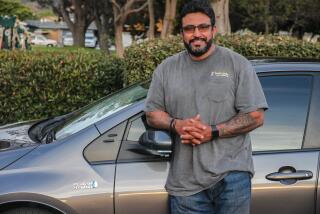Promising Electric Car Battery Wins First Pact : Technology: Energy Conversion Devices of Michigan gets $18.5 million for development from a government-industry consortium.
- Share via
DETROIT — The first battery to be embraced by a government-industry consortium looking for electric car breakthroughs offers the most power per pound of any such technology but could cost upward of $4,000 apiece, its developers said Tuesday.
The high upfront cost would be more than offset by its promised lifetime of usage and other advantages, leading to less than half the 15 to 20 cents per mile operating cost of a gasoline-powered car over 100,000 miles, said Energy Conversion Devices Inc. of Troy, Mich.
The big question, industry officials said, is whether the promise of the company’s nickel metal-hydride batteries can be fulfilled in bigger versions and manufactured economically to feed an emerging electric vehicle industry.
As expected, an ECD subsidiary, Ovonic Battery Co., was awarded an $18.5-million development contract by the U.S. Advanced Battery Consortium. It is the first of several such contracts expected to be awarded in coming weeks aimed at bringing to market a new battery by the end of 1994.
Ovonic’s nickel metal-hydride batteries--smaller versions of which are being used under license in video camcorders, cellular phones and laptop computers--also pose no hazardous-waste disposal problems and are recyclable, the government said.
Korean auto maker Hyundai has already licensed the Ovonic technology. ECD founder Stanford Ovshinsky said that license and his contract with the consortium were written to favor U.S. interests and protect the know-how developed with help of taxpayer funds. Japan’s Matsushita Electric recently announced plans to develop its own nickel metal-hydride car batteries.
“Hyundai is interested for the same reasons we are,” said John Wallace, chairman of the battery consortium and head of Ford Motor Co.’s electrical vehicle project. “There’s lots of inventing still to do. Our intention is simply to blow by them.”
ECD’s claims were supported in testing by the U.S. Energy Department’s Argonne National Laboratory. The batteries consist of nickel hydroxide and an alloy of vanadium, titanium, zirconium and nickel.
The battery consortium was established last year by General Motors, Ford, Chrysler, the Electric Power Research Institute in Palo Alto and the Energy Department. It will spend $260 million over four years, half of it from taxpayers.
The rush to develop a better battery was triggered by California’s requirement that 2% of the cars sold by each manufacturer be “zero-polluting” as of 1998.
ECD is run by Ovshinsky, a self-educated inventor who has kept his chronically unprofitable firm alive for 32 years on the strength of government contracts and investments by major U.S. and especially Japanese companies interested in the firm’s research into solar cells and other areas.
Only limited commercial production has resulted from ECD’s work, and such onetime partners as Atlantic Richfield Co. have withdrawn in frustration. In the 1970s, Ovshinsky’s bullish forecasts for his publicly traded firm attracted the skeptical oversight of the U.S. Securities and Exchange Commission.
However, Ovshinsky remains highly regarded in Japan’s technology community and has established numerous joint ventures and research contracts with such mainstream firms as Canon Inc. and Matsushita.
Energy Conversion’s shares fell $1.25 to $11 on the NASDAQ market. The stock had surged in recent months from a low of $4.875 early this year.






